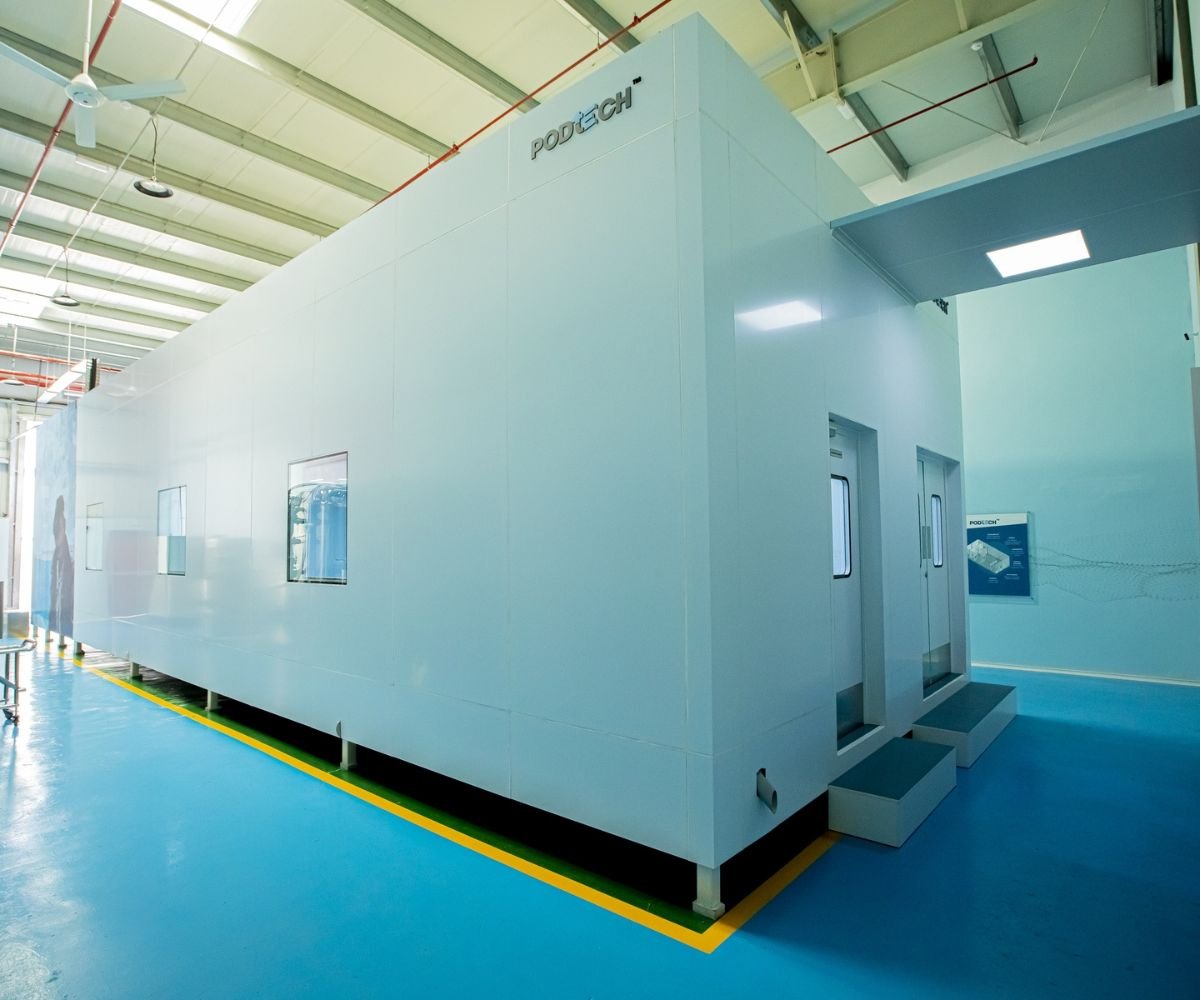Portable Modular Cleanrooms: Revolutionizing Cleanroom Technology
Cleanrooms play a crucial role in maintaining sterile and controlled environments necessary for industries like pharmaceuticals, electronics manufacturing, and biotechnology. Traditionally, constructing cleanrooms has been a time-consuming and expensive endeavour. However, with advancements in technology, portable modular cleanrooms have emerged as a cost-effective and flexible solution.
Advantages of Portable Modular Cleanrooms
Portable modular cleanrooms offer several advantages over traditional cleanroom construction. Firstly, they provide unparalleled flexibility in terms of installation and usage. Unlike permanent cleanrooms, which require significant structural modifications, portable modular cleanrooms can be easily assembled, disassembled, and relocated as needed. This makes them ideal for companies with fluctuating space requirements or those operating in rented facilities.
Components of Portable Modular Cleanrooms
Portable modular cleanrooms consist of several key components, including walls and partitions, HVAC systems, flooring materials, and lighting/electrical systems. These components are designed to meet the stringent cleanliness and environmental control standards required by various industries. Walls and partitions are typically constructed from materials such as aluminium or stainless steel, with options for clear panels to facilitate visibility and natural light.
Applications of Portable Modular Cleanrooms
The versatility of portable modular cleanrooms makes them suitable for a wide range of applications. In the pharmaceutical industry, they are used for sterile compounding, drug manufacturing, and packaging. In electronics manufacturing, cleanrooms ensure the quality and reliability of electronic components by preventing contamination from dust and other particles. Biotechnology research facilities utilize cleanrooms for gene editing, cell culture, and other sensitive experiments.
Factors to Consider When Choosing a Portable Modular Cleanroom
When selecting a portable modular cleanroom, several factors must be taken into account. These include size requirements, environmental control specifications (such as temperature and humidity levels), compliance with industry standards (such as ISO 14644 for cleanliness classification), and budget constraints. It is essential to work with a reputable cleanroom provider who can tailor the design to meet specific needs.
Installation and Maintenance of Portable Modular Cleanrooms
The installation process for portable modular cleanrooms is relatively straightforward compared to traditional cleanrooms. Once the components are delivered to the site, experienced technicians can quickly assemble them using basic tools. Routine maintenance procedures, such as filter replacements and air quality testing, are essential for ensuring optimal performance and compliance with regulatory standards.
Case Studies: Successful Implementations of Portable Modular Cleanrooms
Numerous companies have successfully implemented portable modular cleanrooms to meet their cleanroom needs. For example, Pharmaceutical PodTech utilized a modular cleanroom for the production of sterile injectable drugs, resulting in increased efficiency and cost savings.
Future Trends in Portable Modular Cleanroom Technology
The future of portable modular cleanrooms is characterized by advancements in materials, design, and technology. Innovations such as lightweight yet durable construction materials, integrated IoT sensors for real-time monitoring and control, and sustainable building practices will drive the evolution of cleanroom technology. As industries continue to demand higher levels of cleanliness and precision, portable modular cleanrooms will play a crucial role in meeting these requirements.
Challenges and Limitations of Portable Modular Cleanrooms
Despite their many benefits, portable modular cleanrooms also face challenges and limitations. Regulatory compliance remains a significant concern, as cleanrooms must meet strict standards set by organizations such as the FDA and ISO. Additionally, adapting modular cleanrooms to accommodate changing requirements or new technologies can be challenging. Ensuring durability and longevity while maintaining cost-effectiveness is another ongoing challenge for cleanroom manufacturers.
Comparison Between Portable Modular Cleanrooms and Traditional Cleanrooms
A comparison between portable modular cleanrooms and traditional cleanrooms reveals several key differences. While traditional cleanrooms offer the advantage of permanence and customization, they are often prohibitively expensive and time-consuming to construct. Portable modular cleanrooms, on the other hand, provide a more cost-effective and flexible solution, making them ideal for short-term projects or temporary facilities.
Case for Sustainability: Environmental Benefits of Portable Modular Cleanrooms
In addition to their practical advantages, portable modular cleanrooms also offer environmental benefits. Compared to traditional cleanroom construction, which generates significant waste and requires extensive resources, modular cleanrooms produce less construction waste and can be reused or recycled. Furthermore, their energy-efficient design helps reduce overall energy consumption, contributing to sustainability efforts in various industries.
Best Practices for Maximizing the Efficiency of Portable Modular Cleanrooms
To maximize the efficiency and effectiveness of portable modular cleanrooms, companies should implement best practices for operation and maintenance. This includes providing comprehensive training for personnel on cleanroom protocols and procedures, conducting regular inspections and audits to identify and address potential issues, and maintaining detailed documentation of cleanroom activities for compliance and quality assurance purposes.
Ensuring Compliance and Safety in Portable Modular Cleanrooms
Compliance with regulatory requirements and ensuring safety are paramount concerns in cleanroom operations. Companies must adhere to standards set by regulatory agencies such as the FDA, CDC, and OSHA to ensure the cleanliness and safety of their cleanroom environments. This includes implementing safety protocols for handling hazardous materials, developing emergency response plans, and conducting regular audits to verify compliance.
Market Analysis: Growth Prospects for Portable Modular Cleanrooms
The market for portable modular cleanrooms is expected to experience significant growth in the coming years. Factors driving this growth include increasing demand from industries such as pharmaceuticals, electronics, and biotechnology, as well as advancements in cleanroom technology and design. Key players in the industry are investing in research and development to introduce innovative solutions that address the evolving needs of customers.
Read Also: Local Movers and Packers in Dubai: Simplifying Your Relocation
Conclusion
Portable modular cleanrooms represent a revolutionary approach to cleanroom technology, offering unparalleled flexibility, cost-effectiveness, and environmental sustainability. From pharmaceutical manufacturing to biotech research, these versatile cleanrooms play a vital role in ensuring the quality and safety of products across various industries. As technology continues to advance and industries demand higher standards of cleanliness, portable modular cleanrooms will remain at the forefront of innovation.
FAQs (Frequently Asked Questions)
Q. Are portable modular cleanrooms suitable for long-term use?
Ans. Portable modular cleanrooms can be designed and constructed for both short-term and long-term use, depending on the specific requirements of the application.
Q. How customizable are portable modular cleanrooms?
Ans. Portable modular cleanrooms offer a high degree of customization, allowing companies to tailor the design to meet their unique space and environmental control requirements.
Q. What maintenance procedures are required for portable modular cleanrooms?
Ans. Routine maintenance procedures for portable modular cleanrooms include filter replacements, air quality testing, and regular inspections to ensure optimal performance and compliance with regulatory standards.
Q. Are portable modular cleanrooms compliant with industry standards?
Ans. Yes, reputable cleanroom providers ensure that their portable modular cleanrooms meet industry standards such as ISO 14644 for cleanliness classification and FDA regulations for pharmaceutical manufacturing.
Q. Can portable modular cleanrooms be expanded or relocated?
Ans. Yes, one of the key advantages of portable modular cleanrooms is their flexibility. They can be easily expanded, reconfigured, or relocated to accommodate changing space requirements or facility layouts.







